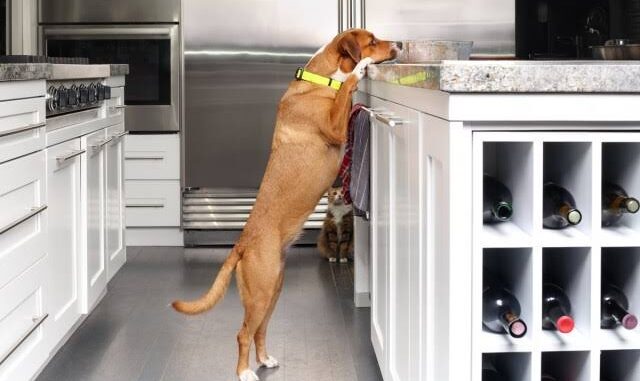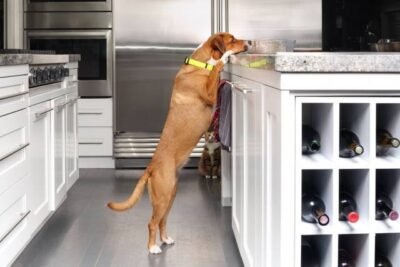
Pets bring immense joy, companionship, and love into our lives, but they also come with the responsibility of keeping them safe from harm. Many common household items, foods, and chemicals that are benign to us can pose significant risks to our pets. Ensuring your pet’s safety requires awareness of potential dangers and proactive measures to eliminate or manage them.

How to Protect Your Pet from Common Household Hazards
1. Toxic Foods and Beverages
One of the most prevalent dangers to pets is the accidental consumption of toxic foods. Many human foods, including those considered staples in a typical household, can cause severe health issues for animals. Some foods that should always be kept out of reach include:
- Chocolate: Contains theobromine, which can lead to vomiting, diarrhea, seizures, or even death in severe cases.
- Onions and Garlic: Both contain compounds that can damage red blood cells and cause anemia in dogs and cats.
- Grapes and Raisins: Even a small amount can lead to kidney failure in dogs.
- Xylitol: A sugar substitute found in many sugar-free products like gum and baked goods. It can cause a rapid insulin release, resulting in hypoglycemia, seizures, or liver failure.
- Alcohol: Can cause intoxication, vomiting, and even respiratory failure in pets.
Prevention: Keep human foods out of reach, use baby gates, and store foods in secure cabinets. Ensure that your guests are aware of the dangers of feeding pets human food.
2. Cleaning Supplies and Chemicals
Many household cleaning products, such as disinfectants, bleach, and glass cleaners, contain chemicals that are toxic to pets. Even products marketed as “natural” or “pet-safe” can still pose risks if not used properly.
- Bleach and ammonia: These harsh chemicals can cause burns to the pet’s mouth, stomach, and skin. Ingestion can be fatal.
- Antifreeze: A small amount of antifreeze, which is sweet-tasting, can be lethal to pets. It’s especially dangerous in colder months when it may leak onto the ground.
Prevention: Always store cleaning products and chemicals in locked, high cabinets. After cleaning, make sure that the area is completely dry before allowing your pet to access it. If you use antifreeze, ensure that spills are cleaned up immediately and safely dispose of any containers.
3. Plants
Certain houseplants, although beautiful, can be highly toxic to pets, particularly cats and dogs. Some common household plants that pose risks include:
- Lilies: All parts of the lily plant are toxic to cats, and ingestion can cause kidney failure.
- Sago Palm: This popular ornamental plant contains toxins that can cause liver failure and death if ingested by dogs.
- Pothos: This common houseplant can cause vomiting, oral irritation, and difficulty swallowing if chewed on by pets.
- Aloe Vera: While it’s commonly used for skin care in humans, it can cause vomiting, lethargy, and diarrhea in pets when ingested.
Prevention: Research the plants in your home to determine their toxicity to pets. Consider swapping toxic plants for safer alternatives or placing hazardous plants out of reach.
4. Electrical Cords and Appliances
Pets, especially puppies and kittens, tend to chew on things, including electrical cords. This habit can lead to life-threatening shocks or burns.
Prevention: Use cord protectors to cover electrical cables or place cords behind furniture. Unplug appliances when not in use, and use pet-safe electrical outlets where possible. If your pet continues to chew on cords, consult a trainer or behaviorist for additional solutions.
5. Medications and Over-the-Counter Drugs
Pets are often curious and may try to ingest medications left out on countertops or in drawers. Both prescription and over-the-counter medications can be toxic, especially painkillers like ibuprofen and acetaminophen.
Prevention: Store all medications, including human and pet prescriptions, in a secure cabinet. Never leave medicine within your pet’s reach. If you suspect your pet has ingested medication, contact a veterinarian immediately.
6. Small Objects and Toys
Choking hazards are a significant concern, particularly for pets that enjoy chewing. Small objects, such as buttons, hair ties, or toys with detachable parts, can be easily swallowed and cause blockages or choking.
Prevention: Regularly inspect toys and household items to ensure they are pet-safe. Choose appropriately sized toys for your pet and monitor them while playing. Always remove small objects like hair ties or rubber bands that may be within reach.
7. Heaters, Stoves, and Fireplaces
Pets can easily burn themselves if they come into contact with hot surfaces like stoves, fireplaces, or space heaters. In addition, they may knock over candles or heating devices, leading to fires.
Prevention: Keep pets out of the kitchen while cooking, use stove guards, and ensure fireplaces have screens. Never leave candles unattended, and keep space heaters out of reach.
8. Pet-Specific Hazards
Some hazards are unique to certain types of pets, such as reptiles, birds, or small mammals. For example, birds may be at risk from Teflon-coated cookware, which can emit toxic fumes when overheated. Small mammals like hamsters may suffer injuries from falling objects or improper cage setups.
Prevention: Research the specific needs of your pet species. For example, avoid Teflon pans if you have birds, and ensure that small mammal cages are secure and escape-proof.
9. Lack of Supervision
Sometimes, even the safest environment can become dangerous if pets are left unsupervised. Pets, especially young ones, are naturally curious and may explore areas of your home that you wouldn’t expect.
Prevention: Always supervise your pets when they’re in new or unsupervised areas of your home. Consider crate training or using baby gates to limit access to risky areas when you’re not around.
READ ALSO: How to Make Your Home Safe for New Pets
FAQs
What should I do if my pet ingests something toxic?
If you suspect your pet has ingested something toxic, immediately contact your veterinarian or an emergency pet poison hotline. Try to keep the packaging of the ingested item or a detailed description to help the professional assess the situation.
Are there any pet-friendly cleaning products available?
Yes! Many brands now offer cleaning products specifically designed to be safe for pets. Look for non-toxic, biodegradable cleaning products that are free of harsh chemicals. Always follow the manufacturer’s instructions, and keep your pets away from cleaned areas until they are completely dry.
How can I pet-proof my home?
To pet-proof your home, start by identifying potential hazards such as toxic plants, harmful foods, and electrical cords. Store dangerous items out of reach, use baby gates to block off dangerous areas, and choose pet-safe products for cleaning and everyday use. Regularly assess your home to ensure it remains safe.
What are the signs of poisoning in pets?
Signs of poisoning can vary depending on the substance ingested but often include vomiting, diarrhea, drooling, lethargy, tremors, or seizures. If you notice any of these signs, seek immediate veterinary assistance.
Leave a Reply
You must be logged in to post a comment.